外研版(2019)必修第二册Unit5 On the road Using language课件(共23张PPT)
文档属性
| 名称 | 外研版(2019)必修第二册Unit5 On the road Using language课件(共23张PPT) |  | |
| 格式 | pptx | ||
| 文件大小 | 2.2MB | ||
| 资源类型 | 教案 | ||
| 版本资源 | 外研版(2019) | ||
| 科目 | 英语 | ||
| 更新时间 | 2024-04-14 22:05:57 | ||
图片预览


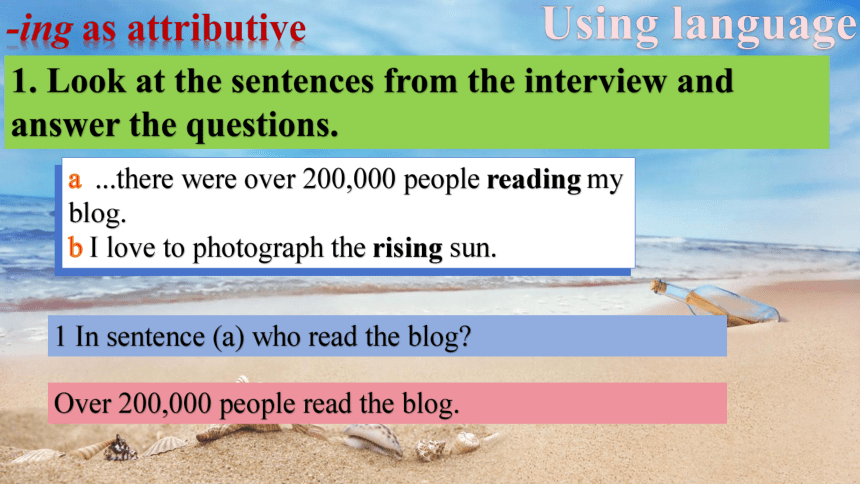

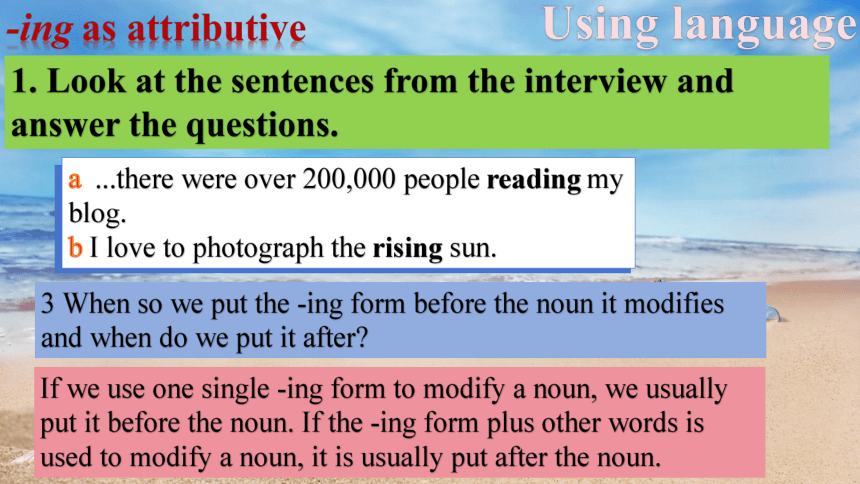
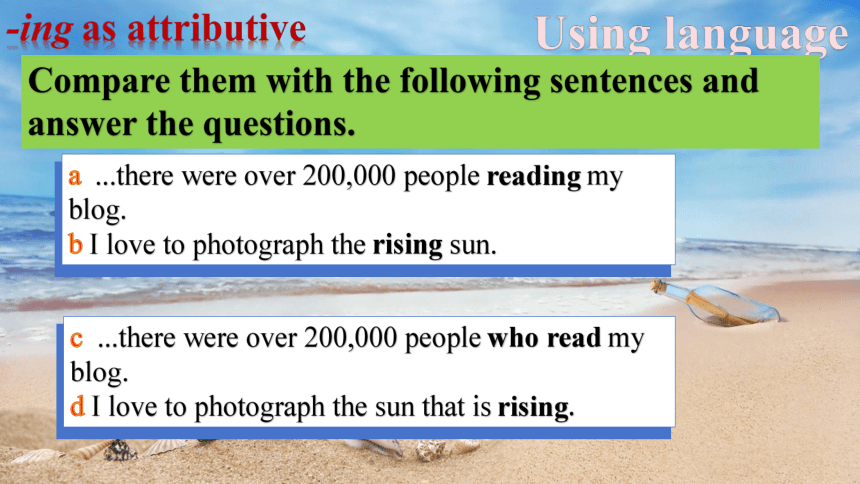

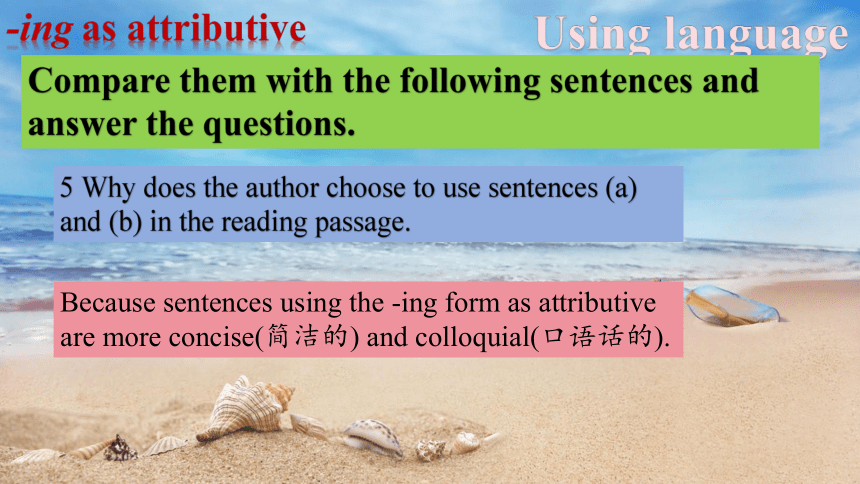
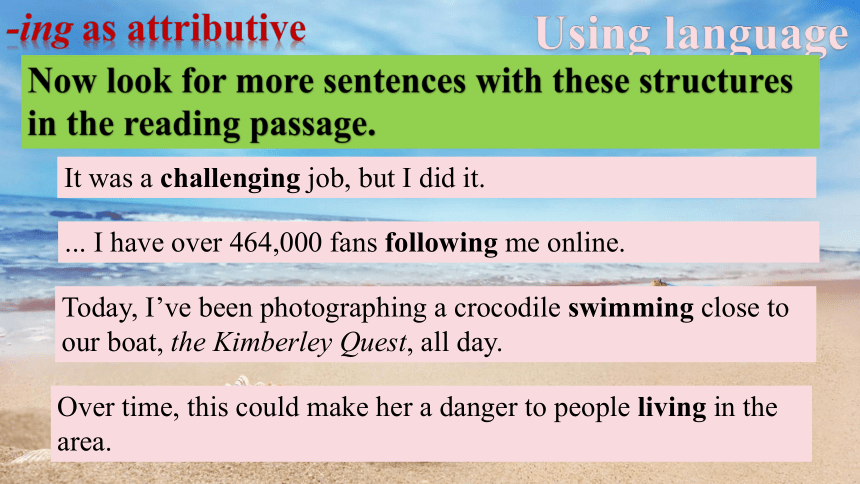
文档简介
(共23张PPT)
Unit 5 On the road
Using language
by Ada
Using language
-ing as attributive
Attributive (定语):用来修饰、限定、说明名词或代词的品质与特征的成分。
种类:主要有形容词、名词、代词、数词、介词短语、动词不定式(短语)、分词、定语从句等相当于形容词的词、短语或句子作定语。
含义:汉语中常翻译为“……的”。
Using language
1. Look at the sentences from the interview and answer the questions.
-ing as attributive
a ...there were over 200,000 people reading my blog.
b I love to photograph the rising sun.
1 In sentence (a) who read the blog
Over 200,000 people read the blog.
Using language
1. Look at the sentences from the interview and answer the questions.
-ing as attributive
a ...there were over 200,000 people reading my blog.
b I love to photograph the rising sun.
2 In sentence (b) what is rising
The sun is rising.
Using language
1. Look at the sentences from the interview and answer the questions.
-ing as attributive
a ...there were over 200,000 people reading my blog.
b I love to photograph the rising sun.
3 When so we put the -ing form before the noun it modifies and when do we put it after
If we use one single -ing form to modify a noun, we usually put it before the noun. If the -ing form plus other words is used to modify a noun, it is usually put after the noun.
Using language
Compare them with the following sentences and answer the questions.
a ...there were over 200,000 people reading my blog.
b I love to photograph the rising sun.
c ...there were over 200,000 people who read my blog.
d I love to photograph the sun that is rising.
-ing as attributive
Using language
Compare them with the following sentences and answer the questions.
4 What is the difference between the two groups of sentences
The first group uses the -ing form as attributive while the second group uses attributive clauses.
-ing as attributive
Using language
Compare them with the following sentences and answer the questions.
5 Why does the author choose to use sentences (a) and (b) in the reading passage.
Because sentences using the -ing form as attributive are more concise(简洁的) and colloquial(口语话的).
-ing as attributive
Using language
Now look for more sentences with these structures in the reading passage.
-ing as attributive
It was a challenging job, but I did it.
... I have over 464,000 fans following me online.
Today, I’ve been photographing a crocodile swimming close to our boat, the Kimberley Quest, all day.
Over time, this could make her a danger to people living in the area.
Using language
-ing as attributive
一,动名词作定语
表示被修饰词的属性、作用或用途,作“供......用”讲,相当于介词for 短语,常置于被修饰词之前。
a swimming pool = a pool for swimming游泳池
a walking stick =_________________ 手杖
a reading room=_________________ 阅览室
a stick for walking
a room for reading
Using language
-ing as attributive
二,现在分词(短语)作定语
表示被修饰词的的动作或状态,被修饰词与现在分词之间使主动关系,相当于一个定语从句。
a sleeping baby = a baby who is sleeping.正在睡觉的婴儿
the rising sun =_________________ 正在升起的太阳
A little child learning to walk often falls.
=A little child_____________________often falls.
学走路的小孩经常摔倒。
the sun that is rising
who is learning to walk
Using language
-ing as attributive
二,现在分词(短语)作定语
表示被修饰词的的动作或状态,被修饰词与现在分词之间使主动关系,相当于一个定语从句。
注意: 现在分词形式作定语时,如果被修饰词与它是被动关系,就用被动式:being done, 表示正在被做。
正在被讨论的问题是校长提出的。
eg. The question being discussed was presented by the headmaster.
Using language
-ing as attributive
a dancing girl a girl dancing on the stage
定语的位置:
Using language
-ing as attributive
定语的位置:
a dancing girl
____的现在分词作定语时,常位于被修饰词____,称为________;
单个
前
前置定语
Using language
-ing as attributive
现在分词______作定语时,位于被修饰词___,称为__________。
定语的位置:
a girl dancing on the stage
短语
后
后置定语
Using language
-ing as attributive
注意:
此类动词有:
exciting, amusing, amazing, astonishing, shocking, confusing, puzzling, disappointing, discouraging, touching, moving, interesting, terrifying, satisfying, frightening 等。
那一定是一段可怕的经历。
eg. That must be a terrifying experience.
(1)有些动词-ing形式已经转化为形容词,常作定语,用来修饰物,表示“令人......的”
Using language
-ing as attributive
(2)下列情况不能用现在分词(短语)作定语,应使用定语从句。
①作定语的现在分词(短语)表示的动作与主句谓语动词表示动作不是同时发生,要使用定语从句。
昨天来的教授将为我们演讲。
eg. The professor who came yesterday will give us a lecture.
Using language
-ing as attributive
(2)下列情况不能用现在分词(短语)作定语,应使用定语从句。
②现在分词(短语)的完成式having done 一般只用来作状语,不作定语。
被地震震坏的庙宇很快将被重建。
eg. The temple which has been destoryed by the earthquake will be re built soon.
Using language
-ing as attributive
2 Rewrite the underlined words using the –ing form.
The Bernina Express follows a route that runs from Eastern Switzerland to Northern Italy.People who travel aboard the Bernina Express have the chance to see incredible views.The landscape that lines the route is beautiful and dramatic, with snowy mountains and green valleys. There is no doubt that the Bernina Express is a journey for travellers who want to get back to nature: the train window becomes the TV screen, and the natural world is the show.
running
traveling
lining
wanting
Using language
-ing as attributive
3 Rewrite the advertisement using the -ing form to make it more compact(紧凑的) and coherent(连贯的).
Are you one of those people who work around the clock Are you getting “itchy feet” Take a look at our new offer: a once-in-a-lifetime adventure to the beautiful islands of Hawaii!
woking
Using language
-ing as attributive
3 Rewrite the advertisement using the -ing form to make it more compact(紧凑的) and coherent(连贯的).
Go on a boat trip to see whales that jump out of the water and hear the song of dolphins that sing. Watch surfers who catch the waves – and maybe even give it a go yourself!
jumping
singing
catching
Using language
-ing as attributive
3 Rewrite the advertisement using the -ing form to make it more compact(紧凑的) and coherent(连贯的).
Put on your hiking boots and explore islands with waterfalls and active volcanoes. And at the end of the day, you won’t want to miss the view of the sun that is setting on the sea!
setting
谢谢观看
Unit 5 On the road
Using language
by Ada
Using language
-ing as attributive
Attributive (定语):用来修饰、限定、说明名词或代词的品质与特征的成分。
种类:主要有形容词、名词、代词、数词、介词短语、动词不定式(短语)、分词、定语从句等相当于形容词的词、短语或句子作定语。
含义:汉语中常翻译为“……的”。
Using language
1. Look at the sentences from the interview and answer the questions.
-ing as attributive
a ...there were over 200,000 people reading my blog.
b I love to photograph the rising sun.
1 In sentence (a) who read the blog
Over 200,000 people read the blog.
Using language
1. Look at the sentences from the interview and answer the questions.
-ing as attributive
a ...there were over 200,000 people reading my blog.
b I love to photograph the rising sun.
2 In sentence (b) what is rising
The sun is rising.
Using language
1. Look at the sentences from the interview and answer the questions.
-ing as attributive
a ...there were over 200,000 people reading my blog.
b I love to photograph the rising sun.
3 When so we put the -ing form before the noun it modifies and when do we put it after
If we use one single -ing form to modify a noun, we usually put it before the noun. If the -ing form plus other words is used to modify a noun, it is usually put after the noun.
Using language
Compare them with the following sentences and answer the questions.
a ...there were over 200,000 people reading my blog.
b I love to photograph the rising sun.
c ...there were over 200,000 people who read my blog.
d I love to photograph the sun that is rising.
-ing as attributive
Using language
Compare them with the following sentences and answer the questions.
4 What is the difference between the two groups of sentences
The first group uses the -ing form as attributive while the second group uses attributive clauses.
-ing as attributive
Using language
Compare them with the following sentences and answer the questions.
5 Why does the author choose to use sentences (a) and (b) in the reading passage.
Because sentences using the -ing form as attributive are more concise(简洁的) and colloquial(口语话的).
-ing as attributive
Using language
Now look for more sentences with these structures in the reading passage.
-ing as attributive
It was a challenging job, but I did it.
... I have over 464,000 fans following me online.
Today, I’ve been photographing a crocodile swimming close to our boat, the Kimberley Quest, all day.
Over time, this could make her a danger to people living in the area.
Using language
-ing as attributive
一,动名词作定语
表示被修饰词的属性、作用或用途,作“供......用”讲,相当于介词for 短语,常置于被修饰词之前。
a swimming pool = a pool for swimming游泳池
a walking stick =_________________ 手杖
a reading room=_________________ 阅览室
a stick for walking
a room for reading
Using language
-ing as attributive
二,现在分词(短语)作定语
表示被修饰词的的动作或状态,被修饰词与现在分词之间使主动关系,相当于一个定语从句。
a sleeping baby = a baby who is sleeping.正在睡觉的婴儿
the rising sun =_________________ 正在升起的太阳
A little child learning to walk often falls.
=A little child_____________________often falls.
学走路的小孩经常摔倒。
the sun that is rising
who is learning to walk
Using language
-ing as attributive
二,现在分词(短语)作定语
表示被修饰词的的动作或状态,被修饰词与现在分词之间使主动关系,相当于一个定语从句。
注意: 现在分词形式作定语时,如果被修饰词与它是被动关系,就用被动式:being done, 表示正在被做。
正在被讨论的问题是校长提出的。
eg. The question being discussed was presented by the headmaster.
Using language
-ing as attributive
a dancing girl a girl dancing on the stage
定语的位置:
Using language
-ing as attributive
定语的位置:
a dancing girl
____的现在分词作定语时,常位于被修饰词____,称为________;
单个
前
前置定语
Using language
-ing as attributive
现在分词______作定语时,位于被修饰词___,称为__________。
定语的位置:
a girl dancing on the stage
短语
后
后置定语
Using language
-ing as attributive
注意:
此类动词有:
exciting, amusing, amazing, astonishing, shocking, confusing, puzzling, disappointing, discouraging, touching, moving, interesting, terrifying, satisfying, frightening 等。
那一定是一段可怕的经历。
eg. That must be a terrifying experience.
(1)有些动词-ing形式已经转化为形容词,常作定语,用来修饰物,表示“令人......的”
Using language
-ing as attributive
(2)下列情况不能用现在分词(短语)作定语,应使用定语从句。
①作定语的现在分词(短语)表示的动作与主句谓语动词表示动作不是同时发生,要使用定语从句。
昨天来的教授将为我们演讲。
eg. The professor who came yesterday will give us a lecture.
Using language
-ing as attributive
(2)下列情况不能用现在分词(短语)作定语,应使用定语从句。
②现在分词(短语)的完成式having done 一般只用来作状语,不作定语。
被地震震坏的庙宇很快将被重建。
eg. The temple which has been destoryed by the earthquake will be re built soon.
Using language
-ing as attributive
2 Rewrite the underlined words using the –ing form.
The Bernina Express follows a route that runs from Eastern Switzerland to Northern Italy.People who travel aboard the Bernina Express have the chance to see incredible views.The landscape that lines the route is beautiful and dramatic, with snowy mountains and green valleys. There is no doubt that the Bernina Express is a journey for travellers who want to get back to nature: the train window becomes the TV screen, and the natural world is the show.
running
traveling
lining
wanting
Using language
-ing as attributive
3 Rewrite the advertisement using the -ing form to make it more compact(紧凑的) and coherent(连贯的).
Are you one of those people who work around the clock Are you getting “itchy feet” Take a look at our new offer: a once-in-a-lifetime adventure to the beautiful islands of Hawaii!
woking
Using language
-ing as attributive
3 Rewrite the advertisement using the -ing form to make it more compact(紧凑的) and coherent(连贯的).
Go on a boat trip to see whales that jump out of the water and hear the song of dolphins that sing. Watch surfers who catch the waves – and maybe even give it a go yourself!
jumping
singing
catching
Using language
-ing as attributive
3 Rewrite the advertisement using the -ing form to make it more compact(紧凑的) and coherent(连贯的).
Put on your hiking boots and explore islands with waterfalls and active volcanoes. And at the end of the day, you won’t want to miss the view of the sun that is setting on the sea!
setting
谢谢观看
